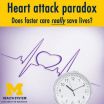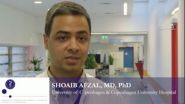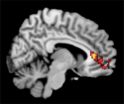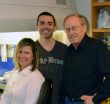It seems like a paradox. But wait, say the authors of the new report: the paradox vanishes with more detailed analysis of exactly who has been getting this treatment.
Far more people are getting emergency angioplasty and stents for heart attacks now than before. That number now includes more people with more complicated health issues that can put them at higher risk for dying in the hospital or soon after.
By comparing individual results and population-level results in a statistical model, the authors of a new paper in the journal Lancet burst the paradoxical bubble. They find that the massive effort by medical teams, hospitals and ambulance companies to reduce the time it takes to deliver treatment has indeed appeared to pay off.
The authors, from the University of Michigan Medical School, Yale University Medical School and other institutions, say their results build upon, rather than contradict, previous key findings. That study found that death rates had not budged, or had gone up, even as treatment time went down.
Thanks to the "open science" movement and the ability to study the same data that others have looked at, but with different tools, the researchers could look deeper into the topic. Their work adds important perspective to understanding the effect of cutting "door-to-balloon time" in primary percutaneous coronary intervention, or pPCI, for patients with ST-elevation myocardial infarction (STEMI), or heart attacks causing a prolonged blockage of blood supply to the heart muscle.
The new paper draws on data from 150,116 pPCI procedures performed in 423 hospitals between 2005 and 2011, including six-month follow-up data in an important subgroup. The data come from the National Cardiovascular Data Registry.
In that seven-year period, the number of pPCI procedures rose 55.4 percent - and the average time between a patient's arrival and the inflation of a tiny balloon to start reopening their blocked blood vessels went down from 86 minutes to 63 minutes.
"This is a big change in a relatively short time, and the result of many people working collaboratively together," says Brahmajee Nallamothu, M.D., MPH, first author and an interventional cardiologist at the U-M Health System. "Treating more patients, with higher risk, over time appears to be why mortality hasn't gone down with door-to-balloon time."
"In the past decade, entire systems of care have been reorganized both inside and outside the hospital around treating heart attack patients with pPCI more rapidly, and seeing the entire process as a medical emergency," continues Nallamothu, an associate professor of internal medicine who cares for patients at U-M's Frankel Cardiovascular Center. "So, people who now receive this procedure are fundamentally different than even a few years before. We now have the ability to perform these procedures on more patients."
Plus, because of the increased effort by ambulance crews to get more patients to a hospital and diagnose their heart attack before they arrive, more patients are surviving long enough to reach the hospital and get triaged for pPCI than ever did before.
And all of this taken together, he and his colleagues found, is where the seeming paradox arose when researchers studied the overall death risk of pPCI patients across the population. Despite years of reduced door-to-balloon times, mortality rates weren't going down - and even appeared to be going up. Even in the new paper, the authors report that this was the case when they looked at mortality across the study population.
That's why the new analysis, which uses a multilevel model and adjusts for individual patient risk factors, was important to do, says senior author Harlan Krumholz, M.D., S.M., of Yale.
"This settles some of the concern that shorter times were not benefiting patients and makes clear that advances in quality of care in terms of timely treatment is very importantly linked with survival after heart attacks," says Krumholz, who is the Harold H. Hines, Jr. Professor of Medicine at Yale and director of the Yale-New Haven Hospital Center for Outcomes Research and Evaluation.
The authors say the new findings don't answer the question of whether the resources poured into reducing door-to-balloon time have "paid off" in terms of the value of lives saved, nor the impact of the cost of false activations of hospitals' pPCI teams and facilities when a patient turns out not to be suffering a STEMI. Also unanswered: whether continued reductions in door-to-balloon time will continue to pay off in reduce individual death risk.
But the new analysis shows the potential danger of taking population data as the last word on an issue, especially when the cohort of people in a given population has grown or changed over time. The population-level analysis published in the New England Journal of Medicine last year showed unchanged mortality in pPCI patients from 2005 to 2009 using the same data source as the new Lancet paper. The new analysis both agrees with and builds upon that previous finding - and it should continue the discussion on the "worth" of faster door-to-balloon times that arose after the NEJM paper came out.
"The prior paper was an important observation but still left us with a question of 'why?'," says Nallamothu. "With this new analysis, we think we have a potential explanation that was previously overlooked. It suggests that our hard work in heart attack care has had an impact on patients, but it is just that we are taking care of different patients these days.
"Interventional cardiologists and teams routinely have to get out of bed at 3 a.m. and quickly get to the cath lab to treat a patient, so they want a real understanding of what rapid treatment is doing for patients," he continues. "The patients we're getting out of bed for these days, when approximately 90 percent of STEMI patients get pPCI, are very different from the ones we treated in 2006, when only about half of that number of STEMI patients received pPCI. And there's more we can do for them as the technologies and medications change. This kind of research helps us understand what the ultimate payoff is."
INFORMATION:
In addition to Nallamothu and Krumholz, the new paper's authors include Timothy P. Hofer, MD, MSc from the U-M Department of Internal Medicine as well as Sharon-Lise T. Normand, PhD, Yongfei Wang, MSc, John E. Brush, Jr, MD, John C. Messenger, MD, Elizabeth H. Bradley, PhD, and John S. Rumsfeld, MD, PhD. The study used data from the NCDR CathPCI Registry, co-sponsored by the American College of Cardiology (ACC) and the Society for Cardiovascular Angiography and Interventions (SCAI). Nallamothu and Hofer are members of the U-M Institute for Healthcare Policy and Innovation, and the VA Center for Clinical Management Research.The research was funded by grant HL105270-05 from the National Heart, Lung, and Blood Institute.




